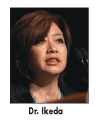3D tomosynthesis promising in breast ca detection
Digital tomosynthesis appears to be more sensitive than digital mammography for detecting breast cancer in a clinical setting, Debra M. Ikeda, MD, of Stanford University, reported at the 2007 San Antonio Breast Cancer Symposium (abstract 46).

SAN ANTONIO-Digital tomosynthesis appears to be more sensitive than digital mammography for detecting breast cancer in a clinical setting, Debra M. Ikeda, MD, of Stanford University, reported at the 2007 San Antonio Breast Cancer Symposium (abstract 46).
“Tomosynthesis is extremely exciting technology that is fast, reproducible and inexpensive,” Dr. Ikeda said.
As background, Dr. Ikeda noted that up to 30% of breast cancers are missed with film mammography screening, often because of “anatomic noise” (seen with dense breast tissue), lack of contrast (no attenuation difference), or a tumor growth pattern that shows a lack of tumor bulk or lack of edge characteristics. These problems are not corrected by the use of digital mammography.
“We expected digital mammography to be better,” she noted. “But foreground and background breast tissue can still hide the cancer.” Tomosynthesis can reduce this anatomic noise, she said.
3D view
Tomosynthesis is a technological outgrowth of digital mammography but offers a three-dimensional view of the breast’s inner structure: film screen mammography artificially flattens such features into two dimensions.
“Consider it like a chest CT compared to a chest x-ray,” Dr. Ikeda said. “With tomosynthesis, you roll through the image, moving back and forth throughout the breast like a CT scan. This gives the radiologist a longer time in which to visualize a mass. ”
Tomosynthesis integrates up to 25 radiographic exposures per breast, each taken from a different vantage point along an arc. The multiple perspectives yield a 3D image of the breast in which tiny virtual slices can be individually examined.
The radiation dose from tomosynthesis is equal to or less than that of a standard two-view mammogram, and less compression of the breast is required during the 20 seconds of data acquisition.
29 patients
In conjunction with researchers from Lund University, Malm, Sweden, Dr. Ikeda conducted a comparative study in a clinical setting that involved 29 patients with subtle signs of breast cancer detected through digital mammographic or clinical screening.
Tomosynthesis was performed on a prototype machine, adapted from the digital Mammomat Novation (Siemens), in the projection in which the finding from mammography was least visible or not visible.
Tomosynthesis results were reviewed for signs of breast cancer by two expert breast radiologists (unblinded), who classified the findings for lesion visibility and probability of cancer using BIRADS categories.
In addition to digital mammography and tomosynthesis, patients underwent ultrasound evaluation and needle biopsy followed by surgery.
Results
Among the 29 women in the study, 33 cancers (average 1.4 cm) were detected in 30 breasts. Histologic types included 17 invasive ductal cancers, 9 invasive lobular cancers, 3 invasive ductal cancers with ductal carcinoma in situ (DCIS), 1 DCIS alone, and 1 intracystic papillary carcinoma.
By BIRADS category, 19 of the 30 breasts with cancer were dense breasts. This included the observations of “dense” in 10 breasts, “heterogeneously dense” in 9, “scattered fibroglandular” in 10, and “fatty” in 1.
The ability to visualize the cancer was evaluated for tomosynthesis vs digital mammography, with each case categorized as “clearly visible,” “visible,” “questionably visible,” or “not visible.”
Tomo vs digital vs ultrasound
Tomosynthesis detected 28 of the 33 cancers, including 15 spiculated masses (2 by tomosynthesis alone), 6 masses combined with calcifications, 5 cases of architectural distortion, and 2 cases of clustered calcifications. In 5 cases, no lesion was visible by tomosynthesis, including 4 in dense breasts detected only by ultrasound and 1 detected by digital mammography.
In 22 cases, findings were more conspicuous on tomosynthesis than on one-view digital mammography; in 10 cases they were equally visible (4 were seen only on ultrasound), and in 1 case, digital mammography was better than tomosynthesis (see Table 1). Two cancers were seen on tomosynthesis alone; both were unexpected second spiculated masses in dense breast tissue in breasts that had one known spiculated tumor.
After tomosynthesis, 17 cases detected on one-view digital mammography were upgraded in BIRADS classification, Dr. Ikeda reported.
The differences between tomosynthesis and two-view digital mammography were less robust (see Table 2). “Tomosynthesis only helped in a couple of cases,” Dr. Ikeda said. Tomosynthesis upgraded the tumor in 11 cases.
Compared with ultrasound, 23 of the 33 tumors were clearly visible on both, 5 were clearly visible or visible on tomosynthesis but not ultrasound, and 5 were clearly visible on ultrasound but not tomosynthesis. Four of these 5 were oval or round masses in dense tissue, and 1 was not included in the tomosynthesis field of view. Digital mammography also missed these 4 cases.
Elaborating on the findings, Dr. Ikeda noted, “Tomosynthesis is extremely sensitive for spiculated masses, and it picks up architectural distortions. Compared with one-view digital mammography, most cancers are seen better by tomosynthesis, and in about one-third of cases, the two modalities are equal. Tomosynthesis also is more likely to upgrade suspicious lesions. It can be very helpful not only in dense breasts but also in fatty breasts.”
Dr. Ikeda and her colleagues concluded that in terms of sensitivity, tomosynthesis is superior to digital mammography alone but is no better than the combination of digital mammography plus targeted ultrasound, and may miss round masses and masses in dense tissue.
This was an unblinded exploratory study aimed at refining future research, Dr. Ikeda said. The next 100 cases, she said, will be evaluated in a blinded design, will evaluate patients not known to have cancer as well as those with known lesions, and will determine specificity.
Investigators at Massachusetts General Hospital and at Dartmouth-Hitchcock Medical Center are also actively evaluating tomosynthesis, and have documented its sensitivity in more than 500 patients. The device is expected to be in clinical use in 5 to 7 years.